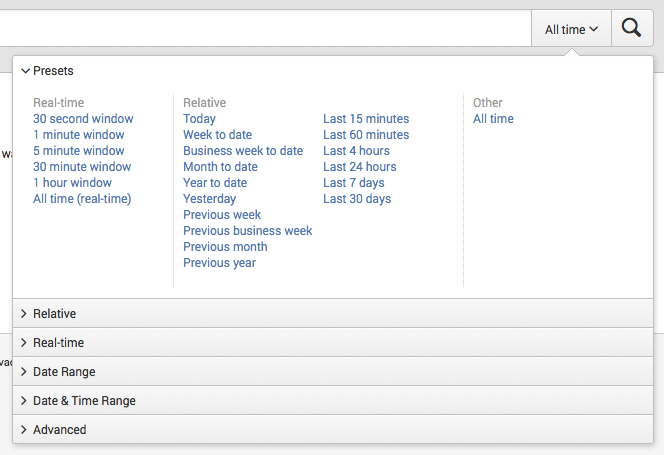- Splunk Answers
- :
- Using Splunk
- :
- Splunk Search
- :
- Calculate time and doubling it from the user selec...
- Subscribe to RSS Feed
- Mark Topic as New
- Mark Topic as Read
- Float this Topic for Current User
- Bookmark Topic
- Subscribe to Topic
- Mute Topic
- Printer Friendly Page
- Mark as New
- Bookmark Message
- Subscribe to Message
- Mute Message
- Subscribe to RSS Feed
- Permalink
- Report Inappropriate Content
Hi all.
I have a normal time selector in splunk that I think that everybody know.

I noticed that in my dashboard it gets used in the following way:
<search>
<query>MY QUERY</query>
<earliest>$field1.earliest$</earliest>
<latest>$field1.latest$</latest>
</search>
Now, what I want to do is to double the time range selected by the user.
For instance, if the user select 1 week, I want to pick 2 weeks.
Same thing for days, months, hours and any time range .
If the user pick some strange period (es: from 1st January to 21 February ) I want to maintain the closest selection (21 February ) and double the chosen time.
1st January to 21 February = 51 days
51 * 2 = 102
21 February - 102 days = 11 November
How can I do this in my code.
I'm also willing to trasform my dashboard in HTML (I think I'll do it anyway later).
Thanks a lot!
Thank you a lot Sundareshr!
I tried to implement your solution but for some reason it does not work.
the code is the following:
BASE QUERY [
| makeresults
| eval earliest=if(isnum($field1.earliest$), $field1.earliest$, relative_time(now(), "$field1.earliest$")
| eval latest=if(isnum($field1.latest$), $field1.latest$, relative_time(now(), "$field1.latest$")
| eval span=latest-earliest
| eval mid=earliest
| eval earliest=earliest-span
| table earliest latest mid]
| eval when=if(_time>relative_time(now(), mid), "Current_Period", "Prev_Period")
| stats count as events by source when
| chart sum(events) by source, when
| eval perc = (Current_Period-Prev_Period)/Prev_Period
| eval trend = case(perc < -0.3, "low", (perc >= -0.3 and perc <= 0.3 ), "madium", perc > 0.3, "high")
| table source, Current_Period, Prev_Period, perc, trend
It shows me the following error
Error in 'eval' command: The expression is malformed. Expected ).
in your part of the code I changed this
eval span=latest=earliest
to this:
eval span=latest-earliest
Because I thought it was a typo
Thanks a lot again
There is something wrong with the formatting that te selector gives to the variable.
If i chose "from the beginning of the week" i get thios error:
Error in 'eval' command: The expression is malformed. An unexpected character is reached at '@w1), @w1, relative_time(now(), "@w1"))'.
for the month is like this:
Error in 'eval' command: The expression is malformed. An unexpected character is reached at '@mon), @mon, relative_time(now(), "@mon"))'.
if i choose always is like this:
Error in 'eval' command: The expression is malformed. An unexpected character is reached at ', relative_time(now(), ""))'.
if i choose between 2 dates is like this:
Error in 'search' command: Unable to parse the search: 'AND' operator is missing a clause on the left hand side.
if i choose last 7 days is like this
Error in 'eval' command: The expression is malformed. Expected ).
Thank you
- Mark as New
- Bookmark Message
- Subscribe to Message
- Mute Message
- Subscribe to RSS Feed
- Permalink
- Report Inappropriate Content
Try this in you search/query (MY QUERY)
base search [
| makeresults
| eval earliest=if(isnum($field1.earliest$), $field1.earliest$, relative_time(now(), "$field1.earliest$"))
| eval latest=if(isnum($field1.latest$), $field1.latest$, relative_time(now(), "$field1.latest$"))
| eval span=latest-earliest
| eval earliest=earliest-span
| table earliest latest ] | rest of your query
And here is rest of your query with calculation for mid
| eval mid=$field1.earliest$
| eval when=if(_time>relative_time(now(), mid), "Current_Period", "Prev_Period")
| stats count as events by source when
| chart sum(events) by source, when
| eval perc = (Current_Period-Prev_Period)/Prev_Period
| eval trend = case(perc < -0.3, "low", (perc >= -0.3 and perc <= 0.3 ), "medium", perc > 0.3, "high")
| table source, Current_Period, Prev_Period, perc, trend
- Mark as New
- Bookmark Message
- Subscribe to Message
- Mute Message
- Subscribe to RSS Feed
- Permalink
- Report Inappropriate Content
Try this in you search/query (MY QUERY)
base search [
| makeresults
| eval earliest=if(isnum($field1.earliest$), $field1.earliest$, relative_time(now(), "$field1.earliest$"))
| eval latest=if(isnum($field1.latest$), $field1.latest$, relative_time(now(), "$field1.latest$"))
| eval span=latest-earliest
| eval earliest=earliest-span
| table earliest latest ] | rest of your query
And here is rest of your query with calculation for mid
| eval mid=$field1.earliest$
| eval when=if(_time>relative_time(now(), mid), "Current_Period", "Prev_Period")
| stats count as events by source when
| chart sum(events) by source, when
| eval perc = (Current_Period-Prev_Period)/Prev_Period
| eval trend = case(perc < -0.3, "low", (perc >= -0.3 and perc <= 0.3 ), "medium", perc > 0.3, "high")
| table source, Current_Period, Prev_Period, perc, trend
